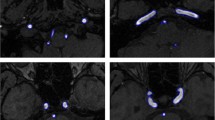Abstract
An algorithm is proposed to perform segmentation of blood vessels in 3D breast MRIs. The blood vessels play an essential role as an additional tool to detect tumors. Large concentration of blood vessels can indicate a malignant mass. Radiologists use a maximum-intensity projection to expose the vasculature. However, the breast is a challenging organ in identifying vascular structures, because of noise and fat tissues. There are several existing algorithms to detect blood vessels in MRI, but those usually prove insufficient when it comes to the breast. Our algorithm provides a three-dimensional model of blood vessels by utilizing texture enhancement, Hessian-based methods and blood vessel completion by center line tracking. We compared the algorithm results to manually segmented images done by radiologists in 24 different patients. They yielded in 86% sensitivity to the ground truth and 88.3% specificity. It also appears that by employing mass detection as the last step, our algorithm can provide a helpful tool for tumor enhancement and automated detection of breast cancer.





Similar content being viewed by others
References
Lesage, D., Angelini, E. D., Bloch, I., & Funka-Lea, G. (2009). A review of 3D vessel lumen segmentation techniques: Models, features and extraction schemes. Medical Images Analysis, 13(6), 819–845.
Weeratunga, S., & Kamath, C. (2004). An investigation of implicit active contours for scientific image segmentation. In Visual communications and image processing conference, San Jose, CA.
Yim, P., Choyke, P. L., Summers, R. M., et al. (2000). Gray-scale skeletonization of small vessels in magnetic resonance angiography. IEEE Transactions on Medical Imaging, 19(6), 568–576.
Manniesing, R., & Niessen, W. (2004). Local speed functions in level set based vessel segmentation. In Proceedings of the medical image computing and computer-assisted intervention (Vol. 3216, pp. 475–482)
Frangi, A. F., Niessen, W. J., Hoogeveen, R. M., van Walsum, T., & Viergever, M. A. (1999). Model-based quantitation of 3-D magnetic resonance angiographic images. IEEE Transactions on medical imaging, 18, 946–956.
Shang, Q., Clements, L., Galloway, R. L., Chapman, W. C., & Benoit, M. (2009). Adaptive directional region growing segmentation of the hepatic vasculature. In Proceedings of SPIE (Vol. 6914).
Huang, X., Zaheer, S., Abdalbari, A., Looi, T., Ren, J., & Drake, J. (2012). Extraction of liver vessel centerlines under guidance of patient-specific models. In Conference proceedings of the IEEE engineering in medicine and biology society
Wink, O., Niessen, W. J., & Viergever, M. A. (2004). Multiscale vessel tracking. IEEE Transactions on Medical Imaging, 23, 130–133.
Lin, M., Chen, J.-H., Nie, K., Nalcioglu, O., & Su, M.-Y. L. (2009). Development of a computer algorithm-based method for identification of blood vessels on dynamic contrast enhanced breast MRI. Proceedings of the International Society for Magnetic Resonance, 17, 4687.
Glotsos, D., Vassiou, K., Kostopoulos, S., Lavdas, E., Kalatzis, I., Asvestas, P., et al. (2013). A modified Seeded Region Growing algorithm for vessel segmentation in breast MRI images for investigating the nature of potential lesions. Journal of Physics: Conference Series, 490.
Demirgüne, D. D., Erta, G., Ilõca, T., Ero, O., & Telatar, Z. (2011). Segmentation of breast region from MR images using multi-state cellular neural networks. In 2011 7th international conference on electrical and electronics engineering (ELECO).
Haralick, R. M., & Shapiro, L. G. (1992). Computer and robot vision (Vol. I, pp. 28–48). Boston: Addison-Wesley.
Barkan, Y., Spitzer, H., & Einav, S. (2008). Brightness contrast–contrast induction model predicts assimilation and inverted assimilation effects. Journal of Vision, 8(7), 1–26.
Polat, U., & Sagi, D. (1993). Lateral interactions between spatial channels: Suppression and facilitation revealed by lateral masking experiments. Vision Research, 33, 993–999.
Lee, T.-C., Kashyap, R. L., & Chu, C.-N. (1994). Building skeleton models via 3-D medial surface/axis thinning algorithms. Computer Vision, Graphics, and Image Processing, 56(6), 462–478.
Aylward, S. R., & Bullitt, E. (2002). Initialization, noise, singularities, and scale in height ridge traversal for tubular object centerline extraction. IEEE Transactions on Medical Imaging, 21, 61–75.
Matichin, H., Einav, S., & Spitzer, H. (2013). A single additive mechanism predicts lateral interactions effects-computational model. M.S. thesis, Tel Aviv University, Tel Aviv, Israel
Acknowledgements
This work was supported in part by the Israel Office of the Chief Scientist under Grant BS123456.
Author information
Authors and Affiliations
Corresponding author
Rights and permissions
About this article
Cite this article
Kahala, G., Sklair, M. & Spitzer, H. Multi-scale Blood Vessel Detection and Segmentation in Breast MRIs. J. Med. Biol. Eng. 39, 424–430 (2019). https://doi.org/10.1007/s40846-018-0418-6
Received:
Accepted:
Published:
Issue Date:
DOI: https://doi.org/10.1007/s40846-018-0418-6




